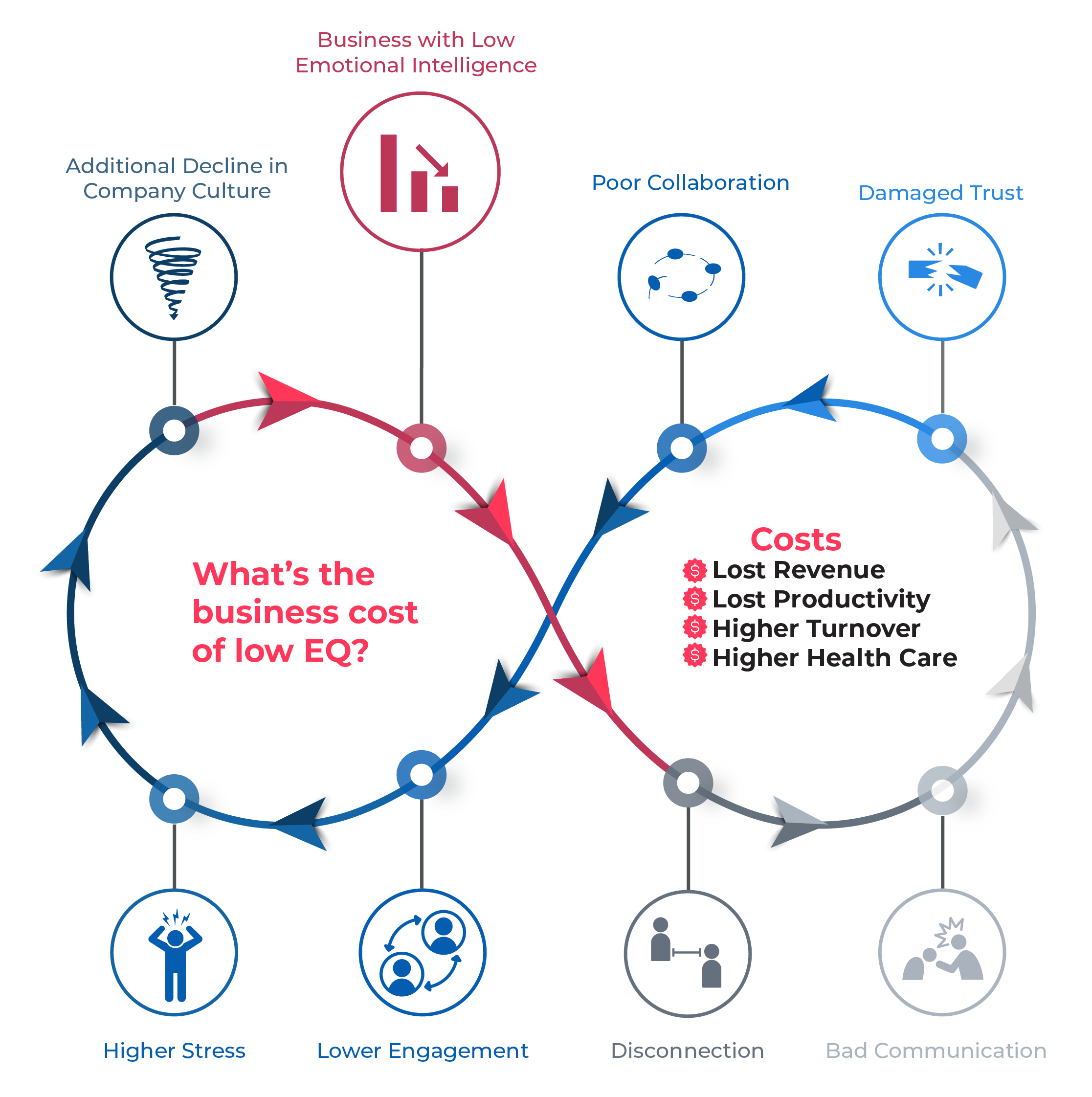How Much Is Low Emotional Intelligence Costing Your Organization?
Low trust and poor communication ultimately result in lost productivity, higher turnover, and lower revenue. Here’s a breakdown of how this chaos loop feeds itself – and how to break the cycle.

Companies are wasting money in an endless cycle of poor communication, broken trust and low employee engagement. The numbers are staggering. Globally, only 21% of employees are engaged. A massive 60% of people are emotionally detached at work and nearly 1 in 5 are miserable, per Gallup. This sad reality has massive financial implications: Employees who are not engaged or who are actively disengaged cost the world $7.8 trillion in lost productivity; 11% of global GDP.
Even worse: These numbers have declined in the last 20 years. Why the lack of success in motivating employees? Leaders use the wrong tools. Low engagement is fundamentally an emotional problem, which organizations try to solve with transactional perks and benefits, like free lunches and deferred stock options. In fact, Fortune 500 companies spend more than ever on benefits and perks – almost $2,500 a year per employee. It still doesn’t work. Golden handcuffs do provide short-term boosts, but research shows again and again that they fail to have a long-term effect on talent retention or performance. Employees want more. Yet leaders rely on these methods because, quite frankly, it’s what they have always done and they don’t know what else to do.
A growing body of research shows that emotional intelligence is what makes a meaningful difference. A leader’s emotional intelligence accounts for as much as 70% of the variation in individual engagement scores, and other research has found the same for teams. This impact ripples throughout the company: Organizations that prioritize emotional intelligence are more productive, more satisfied with their work, more innovative, and more likely to keep their best people. Because of all these things, our research shows that when a company prioritizes emotional intelligence, they are 22x as likely to be high performing.
But those companies are a minority. Most companies continue wasting money in an endless cycle fueled by low emotional intelligence, which brings us back to the original question:
How much is low emotional intelligence costing your organization?
The Infinity Loop of Low Emotional Intelligence
There are two challenges with measuring the cost of low emotional intelligence. The first is that low emotional intelligence manifests itself in so many different ways. Consider these varied examples:
- A micromanaging boss who demoralizes employees with excessive demands and feedback.
- A team leader who plays favorites, and or exhibits erratic, unpredictable behavior.
- A customer facing employee who meets the bare minimum of care and concern.
- An entire team constantly engulfed in blaming and finger pointing.
- A supervisor who makes a promise, only to break it and then never address it.
You could come up with tens of thousands of different examples. These problems all have a lack of emotional intelligence at the root, and that is true for a majority of the problems plaguing organizations all over the world. Based on our research, almost 75% of organizational issues are relational, as opposed to technical. It’s people problems. And for better or worse, people are driven by emotions – and influenced by their own and others’ emotional intelligence.
That brings us to the second challenge of measuring the cost of low emotional intelligence. Whatever the specific problem or example, none of these events happen in a vacuum. They influence and compound each other. The manager’s behavior ripples out to employees, which ripples out to clients. The coworker interaction – good or bad – impacts the next interaction. The UCB case shows what can happen when managers buy-in and the positive effects multiply, but this isn’t the norm. The norm is chaos. The norm is bad communication, high stress, and low engagement, feeding each other in a seemingly endless cycle. Look at this graph. Can you fill in examples from your specific situation of what this looks like? Words or actions that undermined collaboration, or trust?

This is the norm, unfortunately. And it’s an expensive norm.
How expensive?
How to Measure the Costs of Low Emotional Intelligence
Rather than trying to measure the costs of specific actions – say, a manager’s words or actions in a meeting – it’s easier to measure the cost of low emotional intelligence by the outcomes that data shows us to be correlated with it. For example, we know low emotional intelligence is correlated with high turnover. Likewise, low emotional intelligence in the form of a leader lacking self-awareness has been shown to cut a team’s chances of success in half. The costs of low emotional intelligence break down into 3 buckets – lost talent, lost productivity, and lost customer loyalty. We’ll take a look at the role research says emotional intelligence plays in each.
Lost talent
Great employees leave and take invaluable skills, experience and institutional knowledge with them out the door.
When people leave a company, a boss’ or manager’s emotional intelligence – or lack of emotional intelligence – is often a primary or contributing factor. So should it come as a surprise that The Great Resignation, the biggest job market turnover in modern history, coincided with one of the most sustained drops in emotional intelligence since we started tracking with our State of the Heart research? Not really.
At a time of uncertainty and heightened emotional complexity – when emotional intelligence skills are needed most – they declined instead. The result? People moving on, and businesses left grappling for solutions. Case studies like those at Amadori, the leading supplier of McDonald’s in Europe, show that effective emotional intelligence interventions can reduce turnover by as much as 63%. But most organizations double down on material perks, since it’s simple and easy to implement – even though it’s not very effective.
The cost is real. Losing employees is expensive. Replacement costs average $1500 for hourly workers, and a year’s salary for technical roles. In select roles and industries, that number may be significantly higher. One of our oldest clients, for example, is the US Air Force. When they implemented emotional intelligence assessments to better predict quality Pararescue Jumper candidates, a highly demanding course with a high fail rate, they saved over $200 million.
The good news about this cost is that, at least compared to the other buckets, turnover is easily measurable. Companies can calculate the cost, compare itself to competitors, and try to improve upon that figure with targeted and effective interventions. When dealing with the next biggest cost of low emotional intelligence – lost productivity – companies aren’t so lucky to have that clarity.
Lost productivity
Low emotional intelligence means both the quantity and quality of people’s work suffers. Emotions drive people, and people drive performance – for good or bad. The difference is emotional intelligence.
Dealing with colleagues – or, worse yet, leaders – who lack self-awareness and emotional intelligence is exhausting. People are forced to expend valuable energy putting out emotional fires all day long, both internally and externally, instead of using that discretionary effort to do great work. Have you ever felt ignored, or unfairly criticized, or way too stressed after a meeting? Did you go do some of your best work afterward? Probably not. The cumulative effect of low emotional intelligence may not be enough for someone to change jobs, because a lot of factors weigh into a major decision like that, but companies still lose enormous value in the form of stressed, burnt out employees not producing anything close to their best work.
It’s a cycle that’s hard to break. Poor communication leads to damaged trust, which leads to even more strained communication. When we deal with chronic stress, our brains actually rewire to become hypersensitive to threats. In a real, biological way, conflict creates more conflict. We’re more likely to perceive threats, and negative feelings build. Back to the Infinity Cycle above.
Case studies like Westcomm Pump in Canada show that no matter how bleak the climate is, how deep in this cycle a company is stuck, there is always hope for a turnaround. After a rocky transition to a new generation of leaders at Westcomm, 0% of employees scored as engaged in the initial climate assessment. Zero! A full 40% scored as actively disengaged. That’s a trainwreck. Can you imagine what it must have been like to work in that environment? But the leaders bought in, and within months, they began to see a remarkable turnaround. In the post assessment, over 20% of employees scored as engaged and the percent of disengaged employees had dropped from 40% to only 10%. They followed the 4 steps Joshua Freedman outlines in this article, and in less than a year, it felt like a different company.
You can read the full case study here.
Lost customer loyalty
Customer loyalty stems from consistent, positive, emotional experiences. Emotional intelligence has been shown to create those experiences and fuel customer loyalty across industries.
What do casino dealers, restaurant managers and telecom service representatives have in common? They all work jobs in which research has shown emotional intelligence to be a key differentiator driving customer satisfaction and loyalty. This isn’t shocking. Most people wouldn’t be surprised to learn that emotional intelligence is critical in the service sector. But what may be surprising is the extent to which interventions improve outcomes – including company’s bottom line results. Whether in restaurants, casinos, or hotels, emotional intelligence interventions have been shown to increase customer satisfaction by as much as 50%, and market share by up to 25%.
The downstream effects of this increase can hardly be overstated. Loyal customers spend more money than new customers, are more likely to come back after a negative experience, and more likely to make a company profitable.
The market share you’re missing out on by providing average or worse customer service can be hard to calculate precisely, but the link between emotional intelligence and customer loyalty is impossible to ignore.
There is no better time to stop wasting money, and start making emotional intelligence your competitive advantage.
The Business Case for Emotional Intelligence
Want more data on emotional intelligence in business?
This free eBook summarizes the latest groundbreaking research on organizational performance and emotional intelligence, including many of the case studies discussed above. Get your free copy today →
The Surgeon General’s Framework for Workplace Mental Health and Wellbeing
Want an easy way to get started implementing emotional intelligence?
Want to equip your managers with the tools they need to support employee mental health and wellbeing?
Managing Wellbeing is a learning model for managers to better understand and support employees, based on the Surgeon General’s Framework for Mental Health and Wellbeing and the Six Seconds Model of Emotional Intelligence. Learn more →
We’re here to help
Our programs help to increase employee engagement by giving you practical, science-based tools that you can use right away to increase well-being, improve focus, build resilience, and foster innovative collaboration. Want to talk about bringing emotional intelligence to your organization? We’d love to hear from you.
More Emotional Intelligence Data
Increasing Workplace Wellbeing
- Emotional Intelligence at Work:In the Era of AI, What Happens to Human Skills? - November 19, 2024
- Fortifying the Mental Health of the Entire School Community with Emotional Intelligence - October 30, 2024
- Emotional Intelligence at Work: Exploring the Principles of Exceptional Leaders - October 15, 2024

This article should be shared among all LinkedIn groups and professional associations. Without any paid advertising, I have achieved financial and professional success by providing training, assessments, and coaching in Emotional Intelligence. During Covid 19, my work and income greatly increased based on my work providing emotional intelligence assessments and coaching for Emergency Room physicians at ten hospitals in Saudia and many major hospital chains in the U.S., including Tenet Healthcare and Hospital Corporation of America.